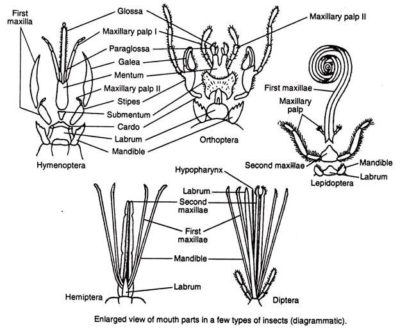
Oral apparatus is an organ that is used for feeding insects. Consists of:
- Upper lip (labrum)
- The upper jaw (mandible)
- Lower jaw (maxilla)
- Lower lip (labium)

In some species of insects such as orders Collembola, Protura, Diplura mouth apparatus lies in the cavity and this the so-called endognathan position lip apparatus. Other insects have ectognathan position oral appliances.
The upper lip is non-articulated plate, which continues in a header shield, it is only part of the oral appliances that are not descended from the extremities. In various insect species has a different shape and role.
The upper jaw are even and non-articulated. In wingless insects are relatively long and knuckled one of the main joint sleeve – monocondial type, and if they knuckled with two joints – dicondial type. The upper surface is notched and tuned for biting. There are 2 zones:
- the molar (basic) – with wider tines for chewable
- the incisor – with sharp tines for tearing
Mandible can be moved towards each other using two powerful muscles; adductor – bigger, stronger, and smaller abductor.
The lower jaw to the sides of the head behind the mandible. They differ from them by articulated and complex structure. The main part of the lower jaw is called a plug or cardo. For him leans powerful ankle – tree or stipes. At the top of the stipes are two plates; external – helmet (lobus externus) or galea, and internal (lobus internus) or lacina. The outside of the stipes is palpus maxilaris.
The lower lip is composed of 2 parts of which are similar in structure, but are grown together by the medium line. The main part of the lower lip is called postmentum. It can be divided into one suture: submentum and mentum. On top prementum carries 4 lobes:
- 2 internal – glossa
- 2 out – paraglossa

Types of oral apparatus
- oral apparatus for nibble
- oral apparatus for licking and slurping
- oral apparatus for thrusting and sucking
- for sucking
- for absorbing
